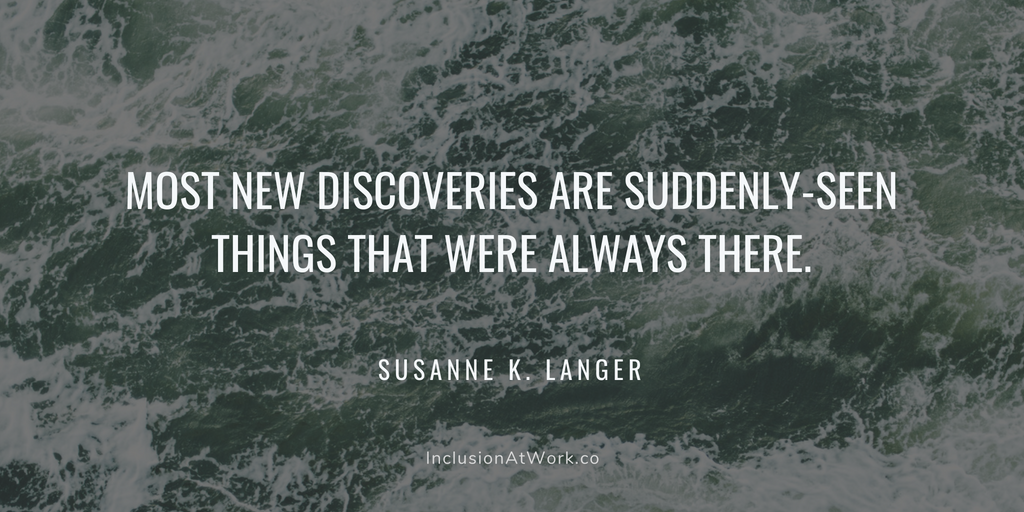Feeling like an impostor in diversity conversations
“I’m a manager and I don’t know how to answer questions about D&I from my team. Help!”

Submit your own question about Diversity & Inclusion here and subscribe to weekly posts here!
∗ ∗ ∗
Dear Inclusion At Work,
You know how when you’ve been talking to someone at a party or event, and you realize you’ve forgotten their name but you can’t ask without being awkward? That’s how I feel asking about Diversity & Inclusion as a straight, white guy in tech. I’ve been reading a lot of articles and blog posts. I know it’s something that really matters and I’m generally supportive. But if I’m being totally honest, in conversations about D&I, I don’t always know what people are talking about and what the goal of all this is.
As a manager at my startup, I’ve been getting more and more questions about D&I. Most of the time, I feel like I’m making answers up on the fly, trying to remember articles I’ve read, or trying to side-step questions altogether. I’d like to be more aware and understand how I can talk about it. What should I do?
-Hiding My Cluelessness
Dear Hiding My Cluelessness,
You’d be hard-pressed to find a manager in tech who hasn’t felt unequipped and uncomfortable addressing questions about D&I. But dealing with (or sidestepping!) those questions at surface level will only take you so far in building an authentic, grounded understanding. So, admitting your lack of knowledge and confidence is actually a really important part of working towards progress!
In starting this advice column, one of my goals was to guide HOW to think, rather than WHAT to think about D&I. I could cite textbook-like definitions or prescribe you a long list of action items, but I’m not sure how effective that is in the long run. Instead, let’s focus on how to develop your own understanding.
The first step is awareness. Have you heard of David Foster Wallace’s parable about fish in the water?
There are these two young fish swimming along, and they happen to meet an older fish swimming the other way, who nods at them and says, “Morning, boys. How’s the water?” And the two young fish swim on for a bit, and then eventually one of them looks over at the other and goes, “What the hell is water?”
I don’t know your full story, Hiding My Cluelessness. But as a straight, white guy in tech, it’s likely you haven’t needed to worry much about D&I before. You were one of the younger fish, relatively unaware of what you’ve been swimming in.
Consider about all the policies, processes, and norms of our workplaces that we don’t even talk about, much less consciously think of – The way people relate to each other, the way work gets divvied up, the way decisions get made. All of that is “water.” You’re not really consciously thinking about it, because it seems so natural. It's simply part of existence.
For many from the majority group, it’s only when you get older, start having children, or develop close relationships with people from marginalized groups that you become more aware of the water. So the first step in D&I often is that simple – just seeing the water. (If you appreciate explanations-through-metaphors, check out this and this too!)
Hungry for more stories about Diversity & Inclusion?
Subscribe to get new posts delivered to your inbox! 📩
Once you notice the water, you’ll probably start realizing how it’s actually not healthy for some fish – or, in our world, people from historically marginalized groups.
As you’re raising your awareness, D&I is still hard to talk about because it’s both universal and deeply personal. Everyone wants to belong, but because of our cultural differences and contexts, we all have different beliefs about what that means. It can quickly become all-too-overwhelming, and you’ll probably end up making some insensitive comments and stepping on some toes. That’s actually pretty typical when you’re starting to become aware.
The goal isn’t perfection, or full awareness of everyone and anyone that’s different than you. Instead, this work is about the process. Paying attention to the experiences of marginalized people will provide clues to drive your actions. It’s not easy, but we can tackle the systematic inequalities and obstacles that get in your way of building the best team and workplace possible.
That’s why D&I is not just about “we need to hire more women.” We do, but this work is so much more than just one demographic.

There’s no way I could have articulated all this just a couple of years ago. My thinking has evolved a lot in the last few years, and will continue to do so. So, it’s ok to not feel super confident about your ability to articulate your views on D&I. Yet. Building understanding takes time.
Please keep on doing your own research, Hiding My Cluelessness. Read books, listen to podcasts, diversify your Twitter feed, and continue to question your own views. And remember that D&I is far more than the studies and the statistics, the work is personal too. We didn't even get to touch the moral arguments nor the social justice lens in this post – more to come in future columns!
Finally, I also encourage you to stop hiding your cluelessness. Take the honesty from your letter, and say it out loud, even though it’ll be uncomfortable. You’d be surprised how an honest acknowledgement like that can create so much space for real conversations – valuable opportunities to listen and learn from others.
In the meantime, keep on trying to see the water because – as a white man, and really, for any of us – it’s a hard, but foundational step. But so worth the effort.
Yours,
Jen
Further reading:
What’s the difference between diversity, inclusion, and equity? by Meg Bolger
Inclusion is a hack by Cate Hurston
Fundamentals of Effective Allyship by Karolina Szczur
The one startup debt you can’t pay back by Phin Barnes
A previous column, “The point of no return” answered a reader Q about whether it’s even possible for a founding team of white men to build a diverse company.
Thanks to Liz Kofman and Bukky Adebayo for edits 💛
Image from Sime Basioli via Unsplash

